Electric cars, like any new technology, evolve rapidly. And when it comes to these, efficiency plays a crucial role. The more efficient a platform is, the better the range, and Hyundai had this in mind when it created the Ioniq 6.
We see a lot of electric SUVs launched lately. The market dictates this, but to some extent it is within reach for manufacturers to create such a vehicle given the space this body type offers.
All this form of SUV can affect the aerodynamic efficiency, an important aspect that influences consumption values and autonomy for better or worse. The Hyundai Ioniq 6 is an exception in the current landscape, thanks to its unconventional design, but which has a well-defined purpose behind it. This electric sedan boasts a drag coefficient of just 0.21, which is also reflected in the exterior design.
Everything has a purpose when it comes to exterior design
Unlike the Ioniq 5, with which it shares the technical platform, the new Hyundai Ioniq 6 has a “slippery” design, with rounded surfaces and elements to eliminate turbulence, all to reduce drag. Viewed from certain angles, the sedan is almost drop-shaped, thanks to the plunging roof and the body that tapers at the rear.
At the front we will find aerodynamic flaps integrated into the bumper, which close and open according to the cooling needs of the car. On the sides we notice an element that comes close to the tire, to prevent air from entering the wheel well. In addition, the design of the 18-inch rims has the same role – to reduce rolling resistance.
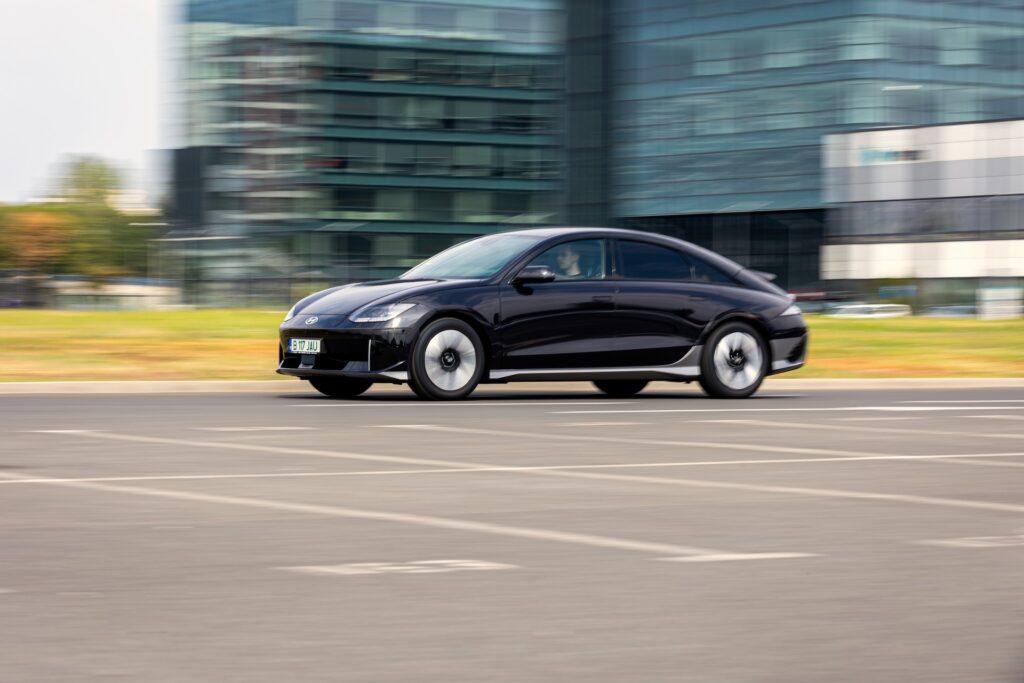
Also on the sides we notice the handles at the same level as the doors, and in the back we are greeted by a familiar air. Ever since I saw the first pictures of the Ioniq 6, one thought always came to mind when I looked at the rear: the Porsche 911.
The shape, but especially the aileron mounted in the extension of the rear window, give you the impression that you are looking at a 911 taken out of Cyberpunk. The LED bar dominated by this pixel motif also contributes to this. The same design can also be found in the daytime running lights, in the third brake stop or on the trunk opening button.
Passenger space is generous, but the trunk suffers a bit
Due to the aerodynamic shape of the body, space in the trunk suffered little. It offers a volume of 401 liters. However, even in basic trim, the Ioniq 6 is equipped with an electrically operated trunk.
Fortunately, things are better in the cabin as there is plenty of room for passengers. The Ioniq 6 measures 4.85 meters long, 1.88 meters wide and has a generous wheelbase of 2.95 meters. Thanks to this, the space for the rear passengers is more than sufficient, at least for the legs.
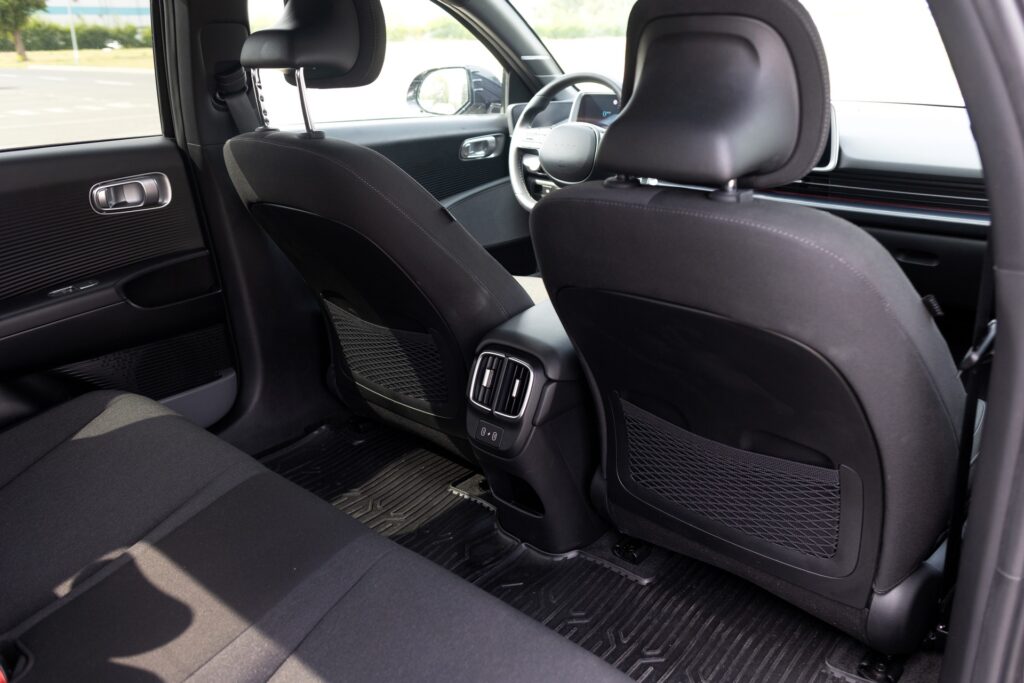
The taller of us may struggle with headroom, a sacrifice made for efficiency. However, most people will have no objection to this chapter. In addition, in the back we find an armrest, two USB-C charging ports, a 220V socket – just like the ones at home – and ventilation holes.
The basic equipment in Romania, namely Premium, offers textile upholstery for the seats, which I don’t think is a bad thing. The material used is pleasant to the touch, feels quality, and the seats are softer than the leather seats I had the opportunity to sit in a year ago, in a fully equipped Ioniq 6.
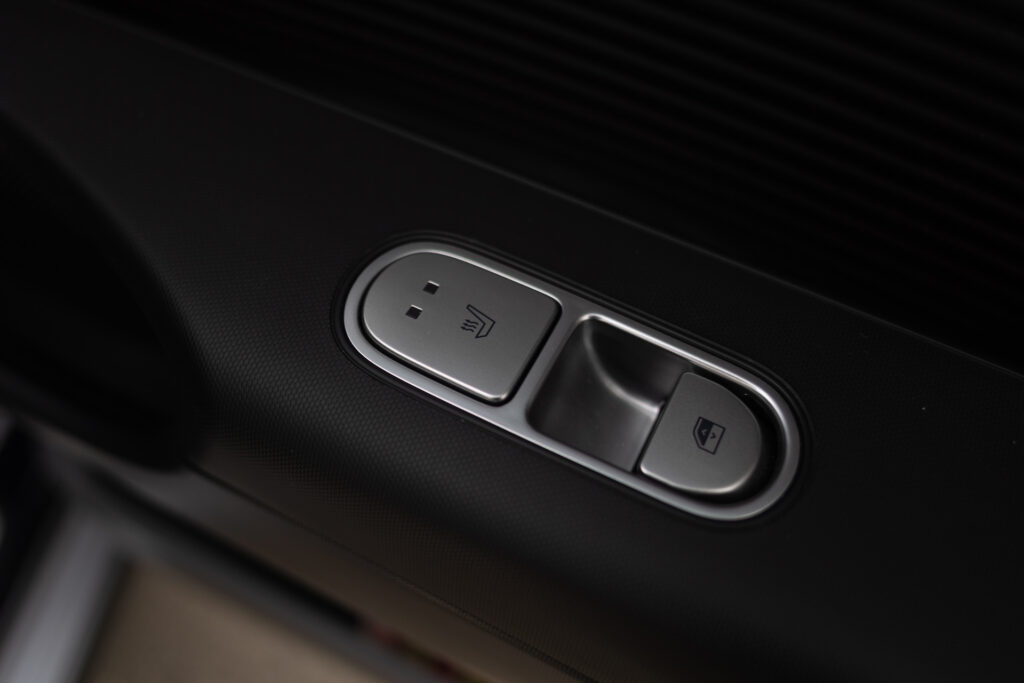
Also, I can’t recommend the sunroof for tall people, as it reduces headroom. Fortunately, the car in our test was not equipped with this option, so we did not experience any problems.
The premium trim level for the Ioniq 6 also includes heated seats, bench seat and steering wheel, as well as electric adjustments for the driver’s seat. It’s easy to find your right position behind the wheel, especially since the steering wheel has ample adjustments and a conventional shape that doesn’t obstruct the instrument panel in any way.
The basic equipment is well equipped
As standard, the Ioniq 6 is equipped with a full suite of assistance systems, such as: adaptive autopilot and emergency braking, blind spot monitoring, 360 cameras, and the car can be controlled from the key when we want to maneuver it in tight spaces.
Each model is equipped with full LED optical blocks, electrically adjustable and heated mirrors, keyless entry system and 18-inch diameter alloy wheels. In addition, smaller rims contribute not only to better autonomy, but also to the comfort of the occupants, so I recommend them.
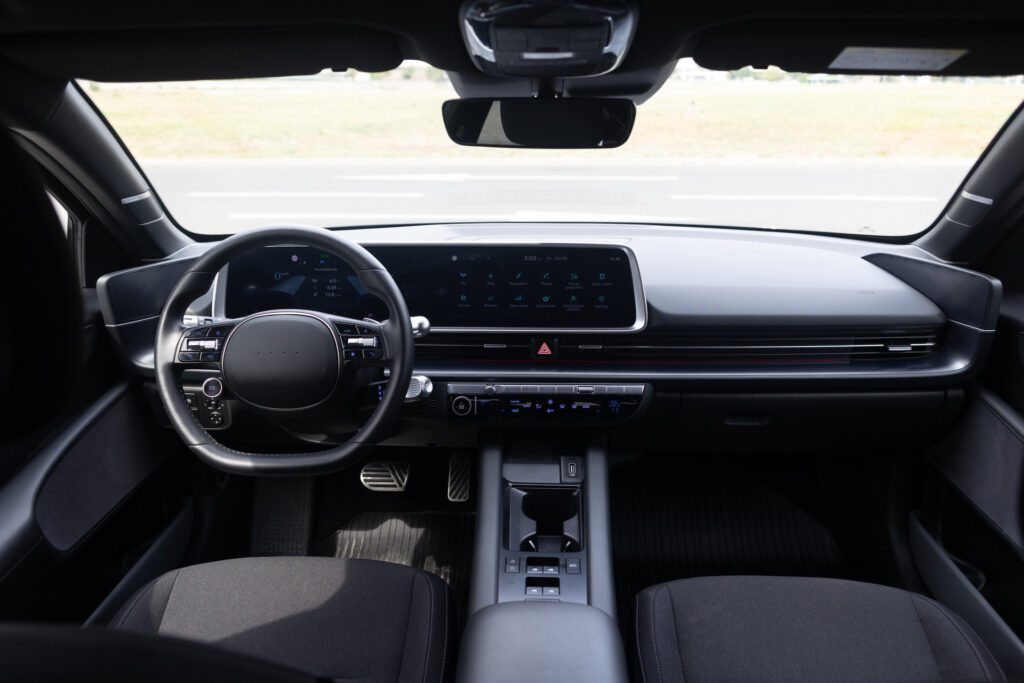
The two 12.3-inch screens are also included as standard. One is used for the dashboard, the other displays the multimedia interface and the camera system, which has a surprisingly good resolution.
The infotainment system is easy to use, with an easy-to-read interface, and includes navigation, but I think most people will opt for Android Auto or Apple CarPlay connectivity. I would have liked to find wireless connectivity with the phone, but the only way is to use a cable. I hope to see Android Auto and wireless Apple CarPlay integration on the facelift.
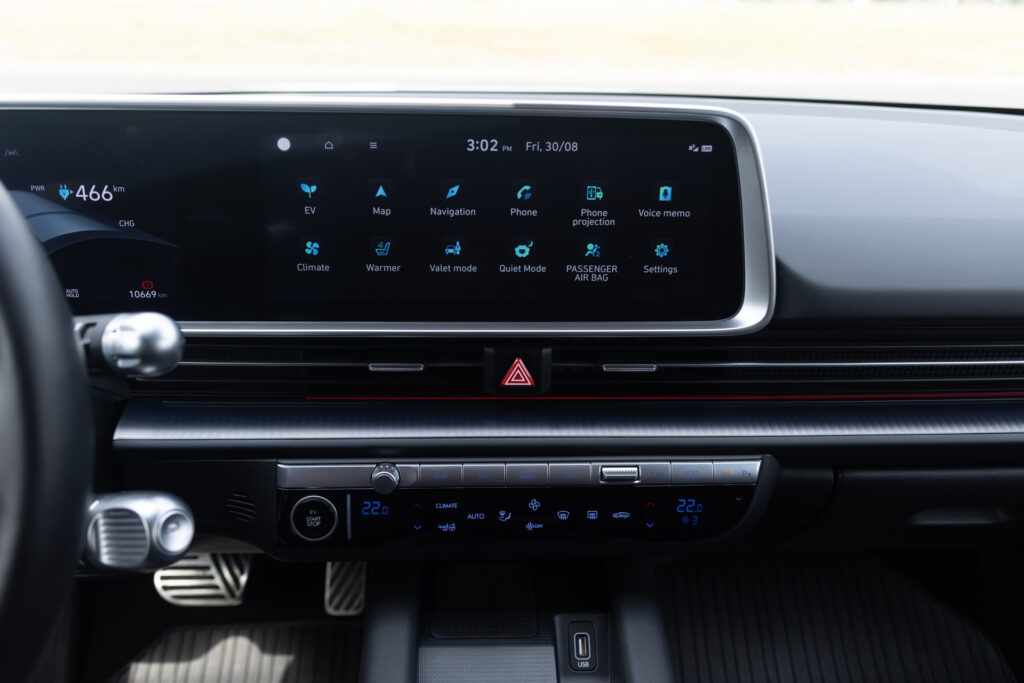
Instead, I appreciated that Hyundai chose to keep the climate floor separate and use physical buttons for many of the controls. Regarding the controls, it will take some getting used to with the window buttons, which have been moved to the center console.
Also here we find a wireless charging pad, two cup holders and a generous storage space right at the base of the console. It’s a welcome compartment, especially since the ones in the door faces are quite small, and the glove box itself isn’t very roomy. Fortunately, this single-engine version also has a frunk that adds another 45 liters to the total storage volume.
Efficiency – the watchword for the Hyundai Ioniq 6
The Korean electric sedan uses an 800-volt architecture, and in the base specification, the Ioniq 6 is equipped with an electric motor of 229 hp and 350 Nm. It is powered by a 77.4 kWh gross/74 kWh net battery. The 229 hp is enough to allow the two-ton sedan to accelerate from 0 to 100 km/h in 7.4 seconds and reach a top speed of 185 km/h.
If that’s not enough, there’s also a version with two electric motors, producing a total of 325 hp and 605 Nm. The version with two electric motors uses the same 77.4 kWh battery, but can sprint from 0 to 100 in 5.1 seconds. Top speed remains the same.
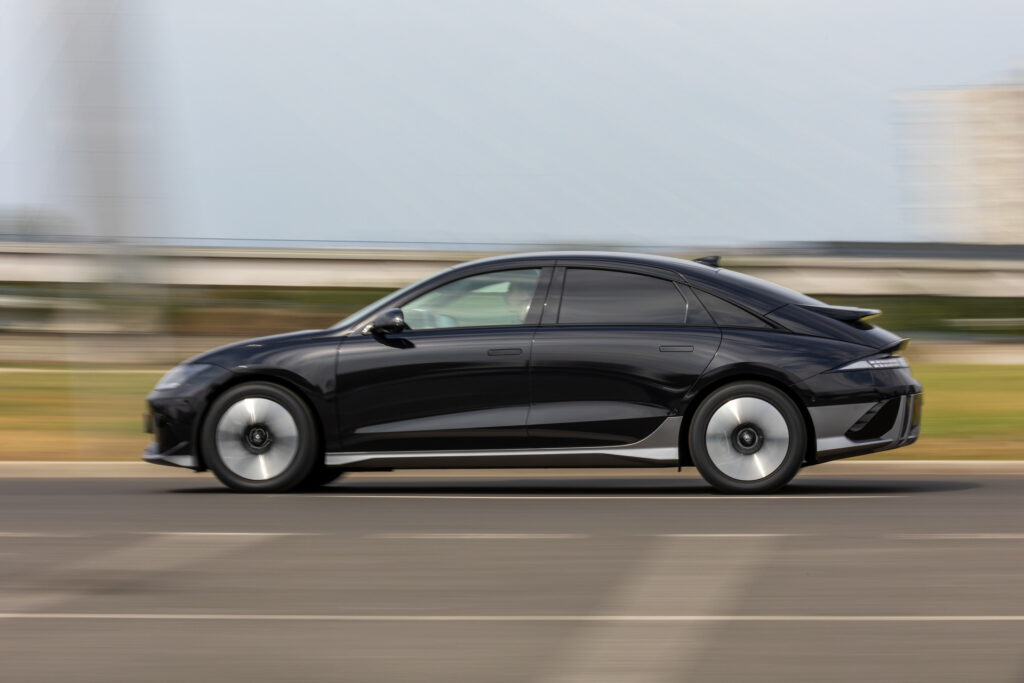
We’ll focus on the Long Range version of the Ioniq 6, which Hyundai says can travel up to 614 kilometers on a single charge. And the car impresses in that it can come very close to this value.
I traveled 470 kilometers on board the Ioniq 6 Long Range, a distance I traveled in the city, on national roads, and on the highway. Much to my surprise, I achieved an average consumption of 12.9 kWh/100 km, lower than Hyundai’s claimed average consumption of 14.3 kWh/100 km. A quick calculation results in a possible autonomy of about 570 km.
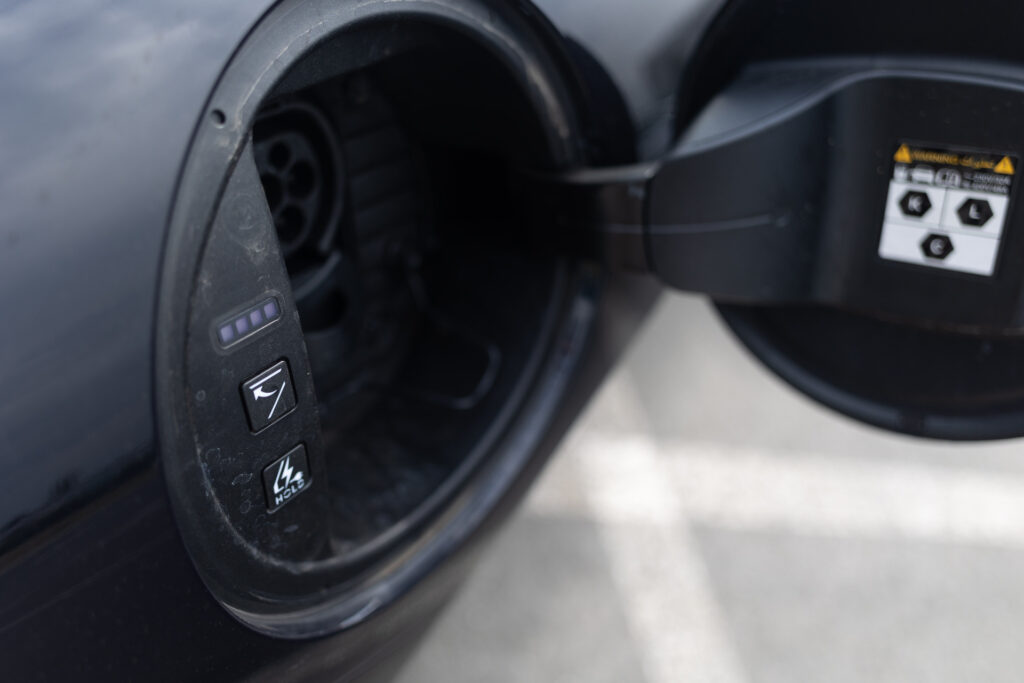
If you know how to use the tools that the car makes available to you, you can get a range of over 500 km very easily. The aerodynamic shape speaks for itself, especially outside the city. With a drag coefficient of just 0.21, the Ioniq 6 is among the most aerodynamic cars you can buy. A side effect of this is that wind noise is kept to a minimum, so at high speeds you’ll especially hear tire noise.
And when it’s time to charge the battery, the Ioniq 6 features AC charging at 11 kW and DC charging at up to 233 kWh. Hyundai says that if a charging station capable of delivering 350 kWh is used, the car can be charged from 10 to 80 percent in 18 minutes.
How does the Hyundai Ioniq 6 drive?
Beyond being an efficient electric car, the Ioniq 6 has good road manners. The suspension is well calibrated, it is not noisy, and the 18-inch rims ensure better driving comfort. Also, the low center of gravity given by the placement of the batteries gives the car good cornering stability. However, the steering doesn’t offer much feedback through the steering wheel, plus Sport mode artificially stiffens it, which doesn’t seem like a plus to me.
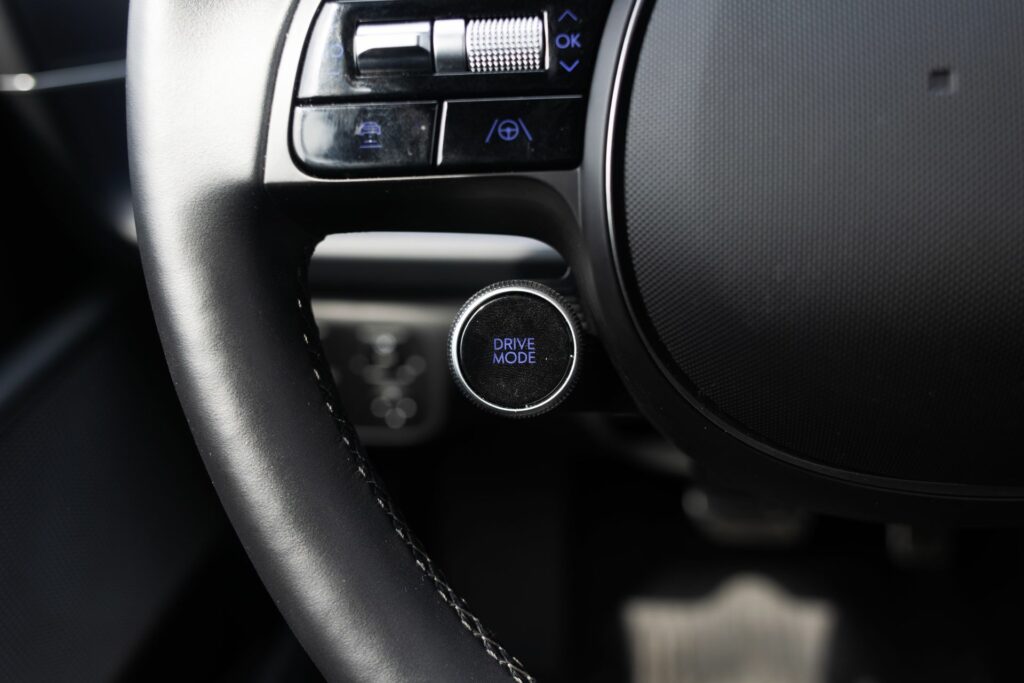
Sport mode also improves throttle response, giving you very good turns for when you want to overtake, for example. Also, regardless of the driving mode selected – Eco, Normal or Sport – the moment you put the pedal to the floor, the car will give you all the resources it has.
It’s not a sports car, not by a long shot, but it knows how to be a comfortable car on a long road. It also feels good at highway speeds, where we recorded consumption of 16-17 kWh/100 km at speeds of 130 km/h, but also in the city. Admittedly, it remains a long car, but one that anyone can park with relative ease thanks to the multitude of cameras and sensors.
ConCluSIonS
So who is the Hyundai Ioniq 6 aimed at? To those who are ready to make the transition to an electric car, I would say. For now, electric mobility isn’t for everyone, but the Ioniq 6 is an easy car to live with.
Its efficiency allows it to travel considerable distances between charges, and when you do need to charge it, you won’t have to wait too long. It’s an attractive option, especially if you live at home and can charge it overnight, and it’s a worthy alternative to the Tesla Model 3, with which it competes directly.
It’s not one of those electrics that offers bombastic acceleration, but it’s a comfortable, technologically advanced and safe car. But all these aspects cost money, and prices for the Hyundai Ioniq 6 in Romania start at 45,363 euros, VAT included. Taking into account the list of standard equipment, the autonomy it is able to offer and the interior space, it is a competitive price in its segment, and the entry level equipment offers a package of equipment that will please many of the customers.
VIDEO
Source: www.promotor.ro


